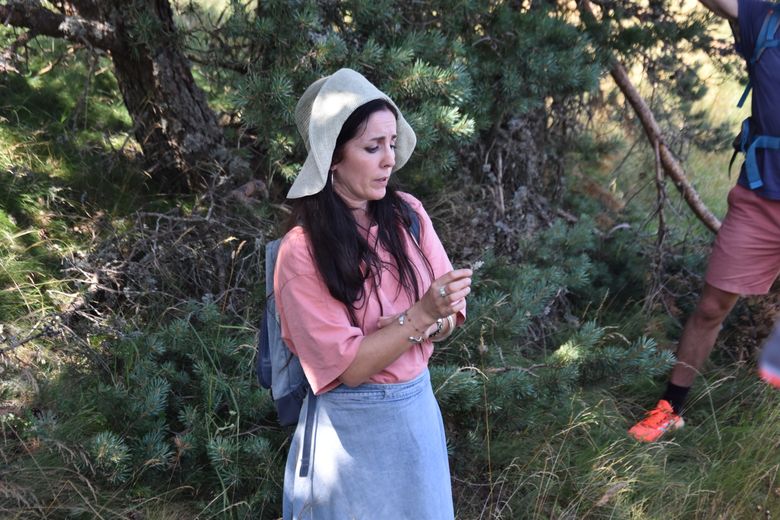A bucolic stroll to discover the secret of the plants of Mont Lozère with the Racines de terriens association

Prune Pellet favors shaded corners during the walk. Midi Libre – Corentin Migoule
While its primary function as a ski resort is not disputed, the Mont Lozère nature resort extends to all four seasons. This is in any case what is reflected in the many summer events that take place there every day, including the bucolic “Secrets de plantes” walk on Wednesday afternoons hosted by the Racines de terriens association.
Wednesday, August 7, 2024, the morning storm that watered a good part of the department did not dampen the ardor of the twenty or so registered for the activity offered in the afternoon by the Mont Lozère nature resort. All responded present for the bucolic walk “Secrets de plantes” led by Prune Pellet, botanist of the Racines de terriens association, under a finally radiant sky and a sometimes burning sun.
The latter had concocted a loop of about two kilometers promoting the discovery of wild plants that grow around the resort. Several children and their parents, retirees, from Cantal, Montélimar (Drôme), Avignon (Vaucluse) and La Rochelle (Charente-Maritime), novices in the field but also connoisseurs capable of citing the Latin name for dandelion – taraxacum – took part with enthusiasm.

The botanist's walk is punctuated with explanations. Midi Libre – Corentin Migoule
A non-exhaustive list of 100 species present in the perimeter was submitted to them, including red clover, early thyme and Forster's stonecrop. But nothing beats learning by doing, or at least by visual discovery, such as those suggested by today's walk.
The small group first lingered over some bedstraw, whose scents, similar to that of honey, they appreciated, before learning more about their dyeing properties, which allow for orange-red tones. But its members did not have the leisure to pick any since this plant is not part of the list of 56 plant species that can be picked by the family in the heart of the Cévennes National Park (PNC) to which this plot belongs.
This is, however, the case of yarrow used in cosmetology for its benefits in the treatment of acne-prone skin. “It has especially hemostatic properties since it stops hemorrhages”, added Prune Pellet, recalling in passing that it belongs to the dandelion family, “like daisies”.

A butterfly has set its sights on this woolly thistle. Midi Libre – Corentin Migoule
Very close to the yarrow identified without difficulty by the participants, there was an intermediate brize, also called the amourette. “It makes a nice bouquet to offer to your other half”, suggests the botanist, insisting moreover on the “symbolic” character of plants that allow to “transmit messages”.
Further on, a pine tree, in this case a Scots pine recognizable by its salmon-colored bark and short needles, did not fail to attract the attention of the host, especially because its branches were overgrown with lichen. “Lichen is used to fix perfumes and delivers iodized notes. They are good indicators of pollution”, proclaims Prune Pellet.
Edible, medicinal, but sometimes toxic plants
Gentian, whose roots are used to make liqueurs – Suze for example – is part of the list of 56 plants for which picking is authorized in the bowels of the PNC. With its orange-yellow flower, mountain arnica was very popular with the children, who know that it can be used in cream or granules to “treat a sore”.
Edible but of no culinary interest, woolly thistle (our photo) was unable to compete with blueberry which, in addition to its taste qualities, increases night vision. “It also has antiseptic properties for the urinary system in case of infection”, added the botanist who had just noticed some buttercups “very toxic”, just like the foxglove.
After a sumptuous break at the belvedere and a return trip along a ski slope, the bucolic walk at an altitude of 1,400 meters came to an end. A group game intended to summarize the day's learning in a fun way awaited the participants, who were visibly won over by the activity.




